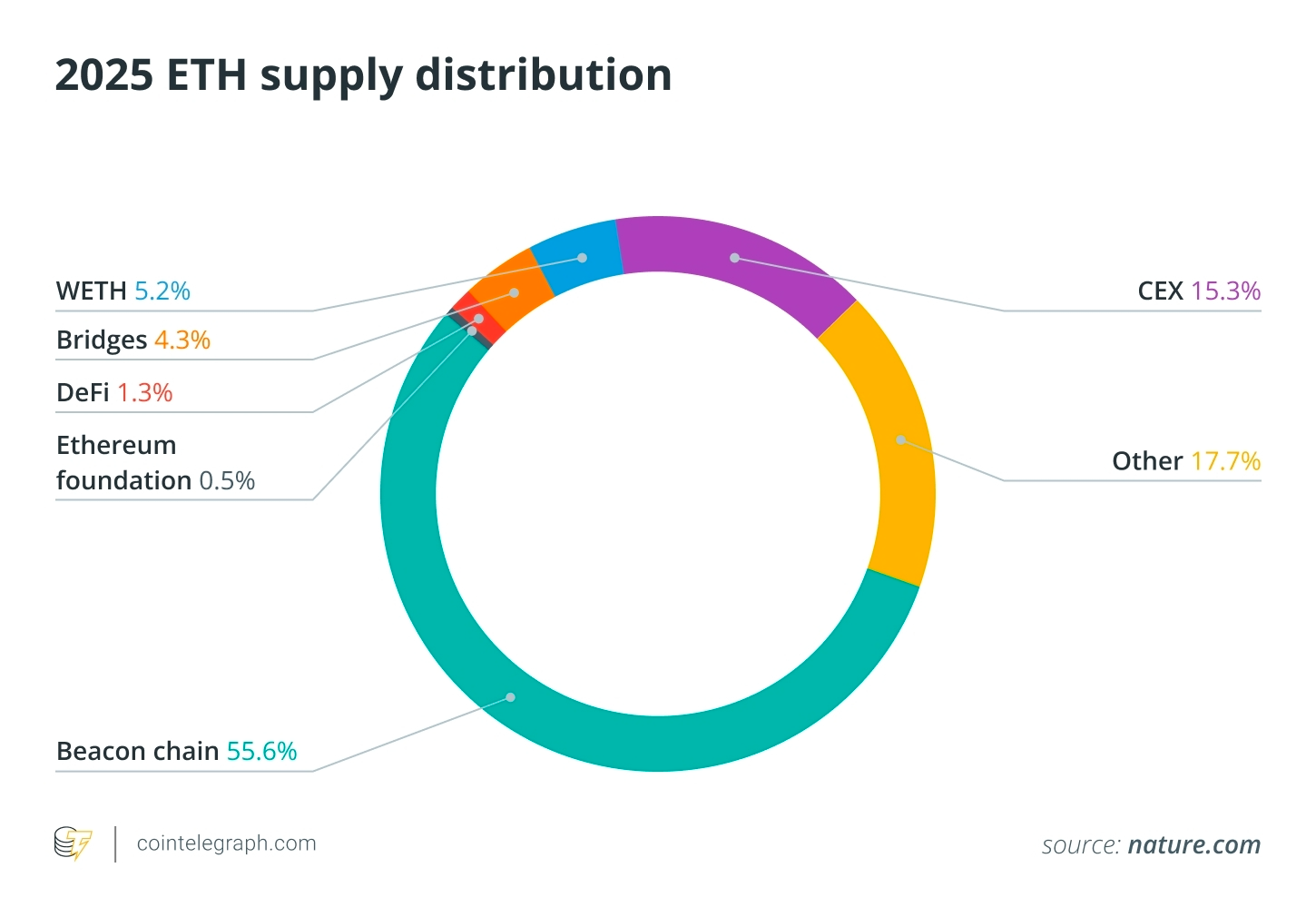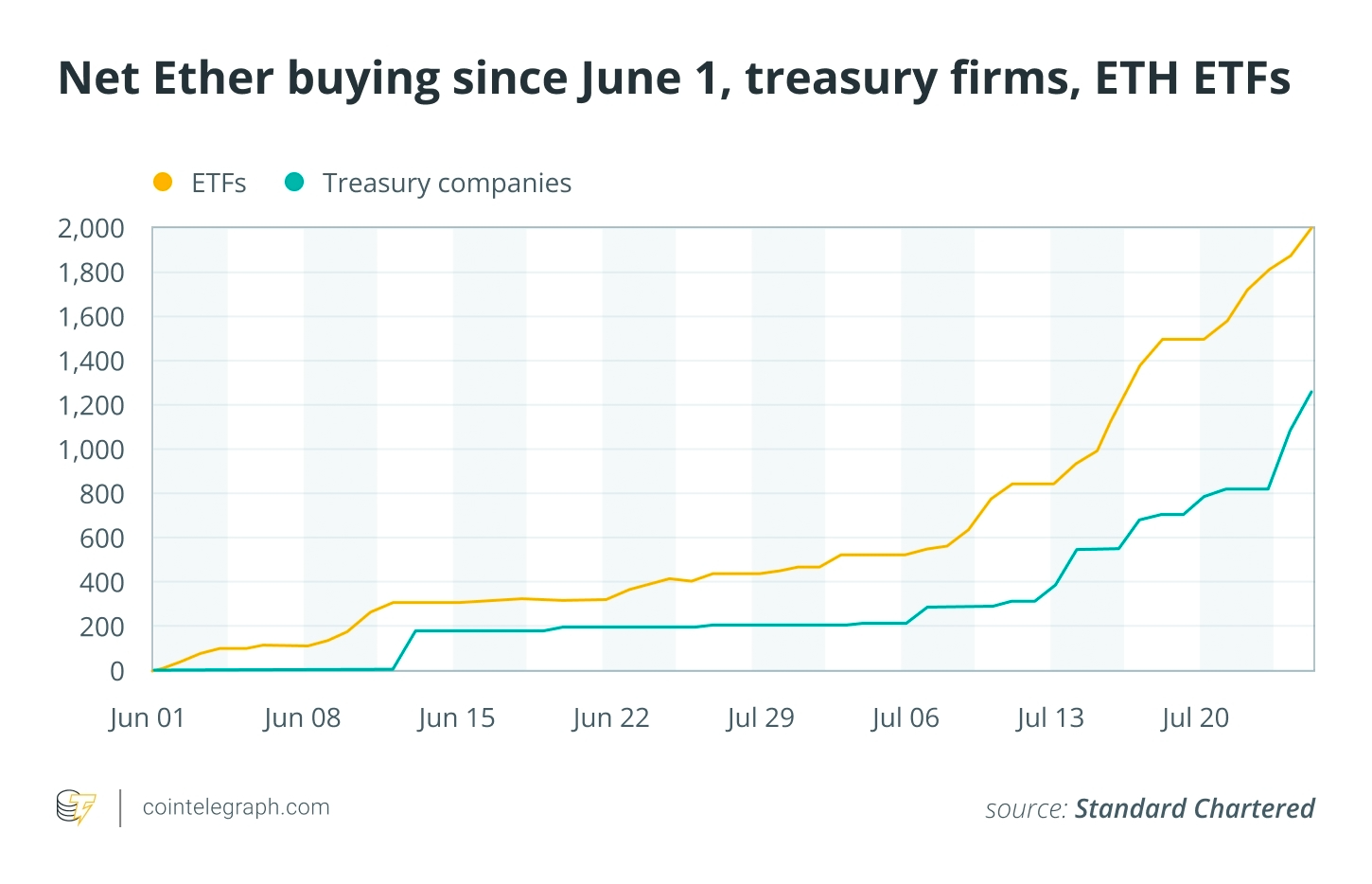X-trader NEWS
Open your markets potential
Who are the 500 billion US dollars of ETH distributed in whom? 2025 Ethereum Rich List revealed

# 70% of Ethereum (ETH) Held by Top 10 Addresses, Mostly Including Staking Contracts, Exchanges, and Institutions
Seventy percent of Ethereum (ETH) is held by the top 10 addresses, primarily consisting of staking contracts, exchanges, and institutions. The Beacon Deposit Contract holds 54.58% of ETH, while institutions such as BlackRock and Fidelity own substantial amounts of ETH. ETH ownership has shifted from early individual holders to institutions and platforms.
**Written by**: Cointelegraph
**Translated by**: White55, Mars Finance
## Key Takeaways
- Approximately 70% of ETH is held by 10 addresses, but most belong to staking contracts, exchanges, or funds rather than individual whales.
- Nearly half of all ETH is held in a single smart contract: the Beacon Deposit Contract that supports Ethereum’s Proof-of-Stake (PoS) system.
- Major institutions (e.g., BlackRock, Fidelity) and public companies now hold millions of ETH, making ETH a significant treasury asset.
- ETH ownership has shifted away from early adopters. Today, the focus centers on the platforms and services built on Ethereum.
As of September 2025, on-chain data shows that the top 10 ETH holders control approximately 83.9 million ETH, accounting for roughly 70% of the total circulating supply.
This has led the community to ask: Who truly holds most of the ETH? The answer points to protocol-level smart contracts, major exchanges, Exchange-Traded Fund (ETF) trusts, and even public companies.
This article explores the 2025 ETH rich list—from the Beacon staking contract and Coinbase’s hot wallet to BlackRock’s ETHA Trust and Vitalik Buterin’s legendary holdings.
## Top ETH Addresses by Balance
By mid-2025, Ethereum’s circulating supply stood at approximately 120.71 million ETH.
Since the Pectra upgrade in May, ETH issuance has stabilized near zero. This provides context for understanding the distribution of ETH ownership.
To elaborate briefly: As of August 4, 2025, the top 10 ETH addresses held 83.9 million ETH (around 70% of the total supply).
On a broader scale, the top 200 wallets accounted for over 52% of the supply, holding more than 62.76 million ETH—most of which is associated with staking contracts, exchange liquidity, token bridges, or custodial funds. Unlike inactive Bitcoin whale addresses, these Ethereum whale addresses serve as actively used infrastructure, reflecting ETH’s ability to support staking, Decentralized Finance (DeFi), and institutional operations.
## Who Owns the Most ETH in 2025?
As of August 4, 2025, the Beacon Deposit Contract held approximately 65.88 million ETH, representing 54.58% of Ethereum’s total circulating supply (120.71 million ETH).
This data aligns roughly with a March 2025 report, which estimated this share at around 55.6% (see chart below).

This smart contract serves as the entry point for Ethereum validators, who must deposit at least 32 ETH to participate in securing the network.
Even after withdrawal functionality was enabled in 2023, funds cannot be moved immediately. Validators must exit the active set, wait for an unbonding period of approximately 27 hours, and then rely on protocol-controlled sweeps to release their ETH.
This makes the Beacon Contract the largest ETH holder—not an individual, but the network itself.
Through severe slashing penalties and a structured exit mechanism, it ensures validator accountability. However, some critics argue that concentrating half the supply in a single contract poses systemic risks in the event of a coordinated exit or a protocol-level vulnerability.
**Did you know?** The Wrapped Ether (WETH) smart contract is also among the largest ETH holders, currently holding over 2.26 million ETH (approximately 1.87% of the circulating supply).
## The Second-Largest ETH Wallets
As of August 22, 2025, the following exchanges and custodians ranked among the largest ETH holders:
- Coinbase: 4.93 million ETH (≈4.09% of the supply)
- Binance: 4.23 million ETH (≈3.51%)
- Bitfinex: 3.28 million ETH (≈2.72%)
- Base Network Bridge: 1.71 million ETH (≈1.4%)
- Robinhood: 1.66 million ETH (≈1.37%)
- Upbit: 1.36 million ETH (≈1.13%).
These addresses represent a layer of active infrastructure, where ETH is used to support exchange liquidity, collateralize derivatives like cbETH, and facilitate cross-chain asset bridging.
## The Largest ETH Wallets in 2025
By late July 2025, BlackRock’s iShares Ethereum Trust (ETHA) drove a major shift in institutional ETH holdings. With net inflows of $9.74 billion, ETHA held over 3 million ETH (≈2.5% of the total supply) as of August 2025, making it one of the largest ETH wallets that year.
Grayscale’s ETHE remained a key player in the crypto market, managing 1.13 million ETH. Fidelity’s Ethereum Fund (FETH), launched in 2024, had attracted $1.4 billion in inflows, while Bitwise was shifting from Bitcoin-only investments to ETH-based managed investments with staking capabilities.
Collectively, these institutions controlled over 5 million ETH (4.4% of the supply), reshaping the landscape of ETH ownership. They represent a new cohort of regulated, ETF-backed, staking-aware DeFi “millionaires.”

## Corporate Ethereum Whale Addresses
A growing number of public companies are following in the footsteps of Strategy’s Bitcoin initiative (but with added staking) by treating ETH as an asset. Examples include, but are not limited to:
- Bitmine Immersion Technologies (NYSE: BMNR): Holds over 776,000 ETH (≈$2 billion), funded via a $250 million PIPE round.
- SharpLink Gaming (NASDAQ: SBET): Has acquired approximately 480,000 ETH (≈$1.65 billion) since June.
- Bit Digital (NASDAQ: BTBT): Holds around 120,000 ETH, shifted from Bitcoin following an equity financing round.
- BTCS (NASDAQ: BTCS): Reports holding approximately 70,028 ETH (≈$275 million), funded through convertible notes.
Most of this ETH is actively staked, generating an annualized yield of approximately 3%-5%. These companies cite Ethereum’s programmability, stablecoin ecosystem, and clear regulatory framework (e.g., the GENIUS Act) as the foundation for their ETH strategies.
This new list of ETH billionaires includes not only individuals but also corporate finance professionals betting on ETH’s long-term value.
## The ETH Billionaires List
While smart contracts and institutions dominate the 2025 Ethereum rich list, a small number of individuals remain major ETH holders:
- Vitalik Buterin, Ethereum co-founder: Widely believed to hold 250,000–280,000 ETH (≈$950 million), primarily stored in a few non-custodial wallets, including the well-known VB3 address.
- Rain Lõhmus, co-founder of LHV Bank: Purchased 250,000 ETH during the 2014 Initial Coin Offering (ICO) but later lost his private keys. His tokens remain unused to this day, currently worth nearly $900 million.
- Cameron Winklevoss and Tyler Winklevoss, early Gemini investors and founders: Reportedly control 150,000–200,000 ETH personally, separate from Gemini Exchange’s reserves of over 360,000 ETH.
- Joseph Lubin, Ethereum co-founder and head of ConsenSys: Estimated to hold approximately 500,000 ETH (≈$1.2 billion), though this has never been officially confirmed.
- Anthony Di Iorio, another Ethereum co-founder: Reported to hold 50,000–100,000 ETH.
**Did you know?** As of early 2025, Etherscan data showed over 130 million unique addresses, but fewer than 1.3 million addresses (less than 1% of the total) held at least 1 ETH. Even owning just 1 ETH places you in the exclusive ranks of the 2025 Ethereum rich list.
## How to Track Ethereum Ownership Distribution
Identifying the largest ETH holders in 2025 relies on tools like Nansen’s Token God Mode, Dune Analytics, and Etherscan. These platforms categorize wallets based on behavior and link them to exchanges, funds, smart contracts, or individuals:
- Token God Mode maps wallet clusters to known entities, tracks inflows/outflows, and ranks the largest ETH wallets of 2025.
- Dune dashboards use schema tables like “labels.addresses” to separate Externally Owned Accounts (EOAs) from smart contracts and exchanges, providing insights into public Ethereum addresses and ETH holding patterns.
- Etherscan labels wallets based on transaction history, attribution information, or user-submitted evidence, enhancing crypto wallet transparency. Together, these sources help outline ETH ownership distribution.
However, limitations persist. Reused deposit addresses may inflate figures, cold wallets may evade cluster tracking, and privacy technologies can obscure true control. Even the top 200 Ethereum addresses may include fragmented or mislabeled entities. ETH address rankings reflect a mix of certainty and statistical inference, not full visibility.
**Did you know?** One of the oldest inactive ETH wallets (likely from the 2014 ICO) still holds approximately 250,000 ETH (≈0.2% of the supply) and has remained untouched for nearly a decade.
### Disclaimer
The views expressed in this article are solely those of the author and do not constitute investment advice for this platform. This platform makes no guarantees regarding the accuracy, completeness, originality, or timeliness of the information contained in the article, nor shall it be liable for any losses arising from the use of or reliance on such information.
Contact: Sarah
Phone: +1 6269975768
Tel: +1 6269975768
Email: xttrader777@gmail.com
Add: Lee Garden One, 33 Hysan Avenue, Causeway Bay, Hong Kong.